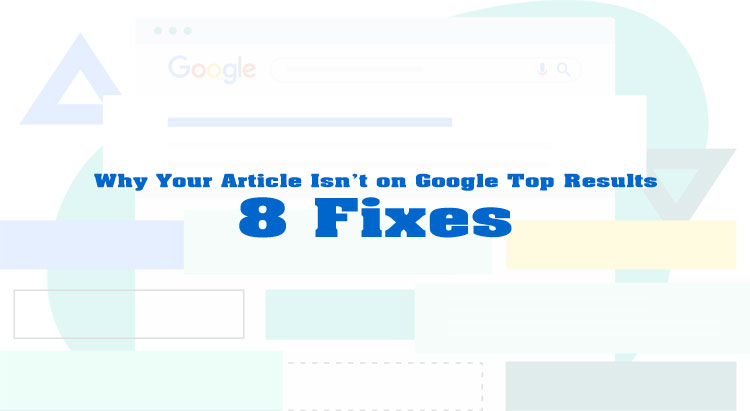Reasons why your article doesn't rank high on Google and how to fix it
- Why Isn’t Your Article Ranking on Google?
- 1. Low-Quality Content
- 2. Poor On-Page SEO Optimization
- 3. Unclear Content Structure
- 4. Your Article Hasn’t Been Indexed
- 5. Lack of Quality Backlinks
- 6. Slow Page Speed
- 7. Not Mobile-Friendly
- 8. No Overall SEO Strategy
- How to Fix It – Tips to Help Your Article Rank on Google
- 1. Focus on High-Quality Content
- 2. Optimize On-Page SEO Properly
- 3. Use a Clear Content Structure
- 4. Submit Your URL to Google Search Console
- 5. Build High-Quality Backlinks
- 6. Improve Page Load Speed
- 7. Make Your Website Mobile-Friendly
- 8. Develop a Long-Term Content Strategy
- Common SEO Mistakes to Avoid - According to Viet SEO's analysis
- Conclusion
Why Isn’t Your Article Ranking on Google?
You’ve followed all the SEO best practices—used the right keywords, optimized your headings, and crafted quality content—but your article still isn’t ranking on Google. VietSEO company breaks down the most common reasons behind this issue and provides actionable solutions to help your content climb the search results and reach the right audience.
1. Low-Quality Content
Google increasingly prioritizes valuable, in-depth, and helpful content for users. If your article:
- Is shallow and lacks depth
- Repeats information from other sources
- Doesn’t offer anything new or useful
…then it will struggle to compete with articles that Google considers high quality.
2. Poor On-Page SEO Optimization
On-page SEO is crucial for helping Google understand your content. Common mistakes include:
- Primary keywords missing from the title, introduction, or H2 headings
- Keyword density too high or too low
- Missing meta tags such as meta description and image alt text
- Lack of proper internal and external linking
3. Unclear Content Structure
Google favors content that is well-organized and easy to read—for both users and search bots. If your article is disorganized, lacks subheadings (H2, H3), or has long, unbroken paragraphs, your ranking may be affected.
4. Your Article Hasn’t Been Indexed
Many people forget to request indexing after publishing. This means the article won’t appear in search results. Other causes include indexing being blocked or misconfigured robots.txt files preventing Google from crawling your content.
5. Lack of Quality Backlinks
Backlinks are a strong ranking factor. If your article has no links from reputable sources—or no backlinks at all—it will have a hard time ranking on Google.
6. Slow Page Speed
Page speed directly affects user experience and technical SEO performance. If your website is hosted on a weak server or loads slowly, Google may penalize it in rankings.
7. Not Mobile-Friendly
Over 60% of users search on mobile devices. Google uses mobile-first indexing, meaning it primarily evaluates the mobile version of your site. If your article isn’t optimized for mobile, it could hurt your ranking.
8. No Overall SEO Strategy
SEO is more than just writing optimized articles. You need a comprehensive strategy—from keyword research and content clustering to technical SEO and promotion. Without a long-term plan, your articles may not perform well in the long run.
How to Fix It – Tips to Help Your Article Rank on Google
Knowing why your article isn’t ranking is only the first step—what matters most is how you fix it. Viet SEO shares practical, proven tips to help your content meet Google’s ranking criteria and reach the Top of Google—from improving keyword placement and content structure to enhancing user experience and technical SEO.
1. Focus on High-Quality Content
- Create original, valuable content
- Aim for in-depth articles of at least 1,500–2,000 words
- Solve real problems your readers are facing
- Update content regularly to keep it fresh
2. Optimize On-Page SEO Properly
-
Place your main keyword in:
-
The title (H1)
-
Meta description
-
The opening paragraph
-
Several H2 or H3 headings
-
- Use secondary keywords and synonyms to enrich content
- Optimize images: use descriptive file names, add alt text, compress file sizes
- Use internal links to help Google understand your site structure
3. Use a Clear Content Structure
- Write an engaging introduction that clearly states the topic
- Break the body into sections using subheadings (H2, H3)
- End with a summary and call-to-action (CTA)
- Use bullet points, tables, and visuals for better readability
4. Submit Your URL to Google Search Console
After publishing your article:
- Go to Google Search Console
- Paste your article link in the search bar
- Click “Request Indexing”
This helps Google discover and index your content faster.
5. Build High-Quality Backlinks
- Share your article on forums and social media
- Exchange backlinks with relevant websites
- Write guest posts for reputable blogs
- Use tools like Ahrefs or Semrush to monitor link quality
6. Improve Page Load Speed
- Choose high-quality hosting
- Compress images and use formats like WebP
- Install caching plugins and optimize code
- Test and improve using Google PageSpeed Insights
7. Make Your Website Mobile-Friendly
- Use a responsive design
- Check mobile usability via Google’s Mobile-Friendly Test
- Optimize fonts and spacing for mobile readability
8. Develop a Long-Term Content Strategy
- Research keyword clusters by topic
- Create pillar content and link it to related articles
- Publish consistently and update old posts
- Analyze competitors and continuously improve your content
Common SEO Mistakes to Avoid - According to Viet SEO's analysis
Even well-intentioned content creators can make critical SEO mistakes that hurt their rankings. VIETSEO highlights the most common errors—like keyword stuffing, poor internal linking, and weak meta tags—and shows you how to avoid them to improve visibility and drive more organic traffic.
1. Keyword Stuffing
While keywords matter, overusing them unnaturally can trigger Google’s spam filters and hurt your rankings.
2. Copying Content
Copy-pasting or spinning content from other sources won’t help. Google detects duplicate content and penalizes it.
3. Ignoring Old Posts
Even top-ranking articles can lose their spot if left outdated. Regularly refresh your content, add new insights, images, and updated links.
4. Neglecting User Experience
Your readers come first. If your article is hard to read, overloaded with ads, or poorly formatted, users will bounce—leading to higher bounce rates and lower rankings.
Conclusion
Getting your article to rank on Google isn’t about luck or quick tricks. It’s a long-term effort involving quality content, technical SEO, and a smart strategy. Viet SEO company reminds you that Google always prioritizes content that’s genuinely helpful, well-structured, user-friendly, and well-integrated into the web ecosystem.
If your article isn’t ranking yet, don’t give up. Apply the methods outlined in this guide, make steady improvements, and you’ll begin to see positive results.
Wishing you success on your journey to conquering Google rankings!



